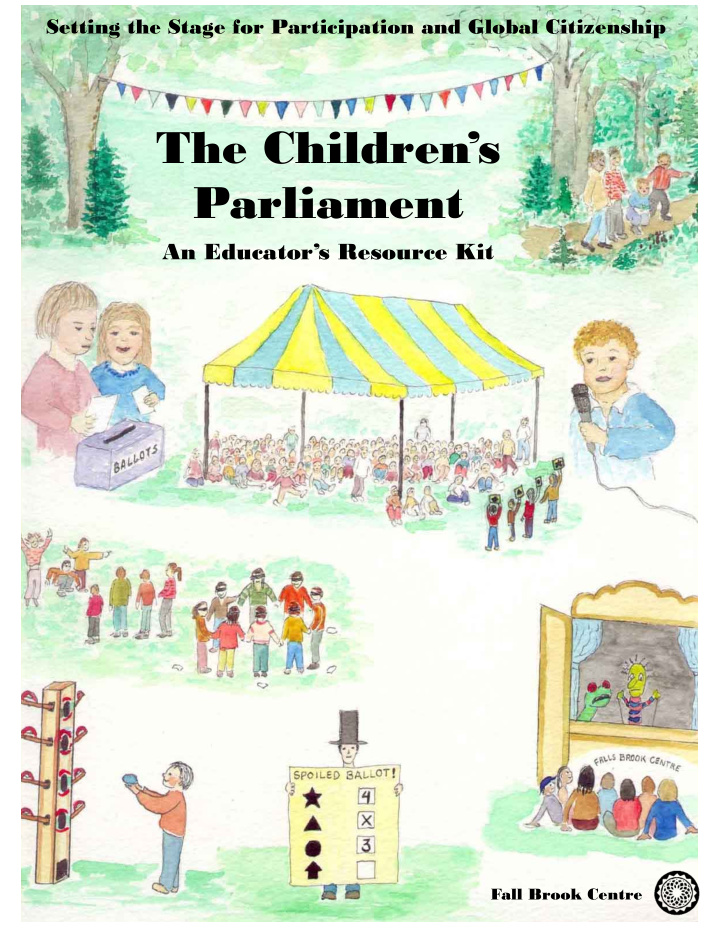



Setting the Stage for Participation and Global Citizenship The Children’s Parliament An Educator’s Resource Kit Resource Kit Fall Brook Centre
Children’s Parliament
The Children’s Parliament An educator’s resource kit Table of Contents Introduction ...................................................................................................................2 Section I: Getting Started ............................................................................................3 Section II: Children’s Fair ...........................................................................................5 Morning Activities ...................................................................................................5 Afternoon Activities .................................................................................................8 Section III: In Session ................................................................................................10 A. Electing Representatives in your school ........................................................10 B. Social Event ........................................................................................................10 C. Running a Session .............................................................................................11 D. Roles in Parliament ...........................................................................................12 E. Organizing a Session .........................................................................................18 Section IV: Responsibilities and Rewards .......................... ..................................20 Conclusion ................................................................................ ..................................22 Appendix A: Activities ..............................................................................................22 About Me .................................................................................................................22 Action Plan Calendar .............................................................................................22 Children’s Rights and Environment ...................................................................23 Classroom Water Activity .....................................................................................23 Global Issues—Cultural Events ...........................................................................25 Icebreakers ...............................................................................................................26 Needs and Wants ....................................................................................................27 Neighborhood Links ..............................................................................................27 Tree Activity ............................................................................................................27 Yarn Friendship Activity .......................................................................................27 Appendix B: Sample Handouts ................................................................................28 Constitution and Bylaws .......................................................................................29 Member of Parliament Candidate Application Form 1 ....................................30 Member of Parliament Candidate Application Form 2 ....................................31 Report of Recognition Form .................................................................................32 Falls Brook Centre Educational Resources .............................................................33 Resource Kit 1
Introduction In 2002 Falls Brook Centre and New Brunswick School District 14 collaborated to help students learn about democracy and citizenship. A group of grade 3-5 students from schools throughout Carleton County became MPs in an assembly modelled after the Canadian Parliamentary system. The Children’s Parliament is an official forum for students to look at local and global problems, and come up with their own solutions. The aim of the project is to inform youth about political processes and get them involved in their schools and communities. Students learn how decisions are made and are also responsible for making some decisions themselves. Through the Chil- dren’s Parliament program, student organize a variety of social and educational activities in their schools including health and fitness events, toy collections for kids in need, and drawing ex- changes with children in India and Nicaragua. The model for this program is the Children’s Parliament created by the Social Work Research Centre in India (www.barefootcollege.org). The first Parliament was such an interesting and enjoyable experience that we hope more teachers and students will become involved. This guide is designed to help you to organize a Children’s Parliament within a group of schools in your area. Included are descriptions of how to attract participants, how to elect candidates, how to run a parliamentary ses- sion, and hopefully everything you will need to get started in your community. Our schedule of activities for the year involves a Children’s Fair, an evening social gath- ering for elected members of parliament and their parents, five parliamentary ses- sions with elected students, and a trip to the Provincial Legislative Assembly. This series of activities works well but all activities and meetings can and should be tailored to the needs of your area. About Falls Brook Centre The Children’s Parliament was organized through the Falls Brook Centre. Falls Brook Centre is a sustainable community demonstration and training centre in rural New Brunswick. Located in Knowlesville on 400 acres of forest and farmland, the centre aims to show that it is possible to live more lightly on our environment while contributing to the local economy. Falls Brook Centre demonstrates sustainable practices through organic gardens, orchards, forest trails and promotion of ecological certification. Other on-site activities include solar and wind energy systems, a small conference centre, herbariums, tree nurseries, and non- timber forest product plantings. Visitors and school groups come to the centre throughout the year to attend workshops and educational programs. The Centre also works with international partners in Mexico, Nicaragua, and India. Children’s Parliament 2
Section I Getting Started Beginning a project like the Children’s Parliament requires a lot of organization and preparation before the fun and learning can begin. Having enthusiastic and dedicated people involved makes the project much easier and more enjoyable for everyone. It is virtually essential to involve grade 3-5 teachers in your area who are interested in participating with their classes. Informing teachers and students through class presentations, e-mails, and telephone calls to local schools are good ways to let people know that the project is beginning. Once you have heard from interested teachers, you can start with the formal application process. Teachers apply to have their class participate in the Parliament and also need the support of their principal. Sample application forms can be found in Appendix B. Once you have enough schools or classes signed up, you can begin to solicit the help of students, parents and volunteers. Expectations from Participants It is important to inform participants of their role in the Children’s Parliament. Outlined below are some of the major duties of participants in the Children’s Parliament - there may be more. Clearly specifying responsibilities and expectations in advance helps those interested in participating know which positions would best suit their abilities, interests and available time. Role of Organizer This is you! Your role is to liaise with teachers, principals and volunteers regarding the events, and to provide materials and protocol for running of the Children’s Parliament. Role of the School District or School Board Having the School District on side aids in facilitating the process of running a multi-school Children’s Parliament. Make presentations to the School District in order to solicit their approval. Support from an eager School Board can come in the form of covering the cost of buses and the supply days needed for accompanying teachers to the Children’s Parliament sessions. Role of the Principal Principals provide teachers and students with the support needed to fully participate in all activities and to encourage students to organize special events for their constituents (their schoolmates). Resource Kit 3
Recommend
More recommend